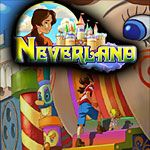Retro Replay Review
Gameplay
Neverland delivers a classic hidden-object experience with a whimsical twist inspired by Lewis Carroll’s timeless tale. Each level presents a richly detailed fantasy landscape, where dozens of toys and curiosities drift, spin, and disappear in the blink of an eye. Your task is to tick off every item on the list at the right side of the screen before time runs out, using keen observation and quick reflexes to catch objects as they dart in and out of view.
(HEY YOU!! We hope you enjoy! We try not to run ads. So basically, this is a very expensive hobby running this site. Please consider joining us for updates, forums, and more. Network w/ us to make some cash or friends while retro gaming, and you can win some free retro games for posting. Okay, carry on 👍)
The ribbon system at the top of the playfield introduces a strategic layer to the core hunt. Hints reveal the precise location of a sought-after toy, pinwheels generate dynamic visual cues around an object by spinning and changing color, and whistles freeze all motion to grant a precious moment of calm. Each power‐up is limited by a charge count that you replenish by collecting matching icons scattered in the environment, or by interacting with certain “hungry” toys in the scene.
Between major chapters, Neverland spices up the routine with an optional mini‐game: a projector repair challenge. You’ll flip three knobs back and forth to sharpen the image, all while mischievous toy creatures leap from the borders to knock your focus off balance. This change of pace tests your dexterity and keeps the experience feeling fresh, even for hidden‐object veterans.
Some stages crank up the difficulty by sending objects on unpredictable paths, emerging and vanishing on their own schedule. This constant motion demands split‐second decisions—click too soon, and you miss; wait too long, and the item disappears again. It’s a satisfying test of patience and precision that will appeal to players who want more than a straightforward picture puzzle.
Graphics
Visually, Neverland paints a vibrant, storybook world full of playful oddities and lush backdrops. Each scene feels hand‐crafted, with soft color palettes that evoke a dreamlike fairy tale. Twirling pinwheels and bouncing dolls animate smoothly, breathing life into environments that could otherwise feel static.
The game’s attention to detail is evident in the varied thematic settings: a mushroom grove dotted with porcelain rabbits, a toymaker’s attic strewn with wooden soldiers, and mirrored corridors where reflections tease you with phantom items. Delicate lighting and subtle particle effects—floating dust motes, drifting petals—add depth without distracting from the hunt.
Animations are crisp, from the satisfying swirl of a helpful pinwheel to the gentle sway of a hanging lantern. Even the UI controls—the hint, pinwheel, and whistle ribbons—are polished, with clear icons and responsive highlighting. Charging icons that pop up on the playfield feel integrated rather than shoehorned in, maintaining the visual flow.
While the resolution may vary between devices, Neverland holds up well on modern screens. The fine details on trinkets remain sharp, and the color transitions never feel jarring. For fans of hidden‐object adventures, the graphics alone are reason enough to step through the looking glass.
Story
At its heart, Neverland borrows the spirit of Alice’s adventures: curiosity leads you into a world where logic is at odds with fantasy. You follow a nameless heroine as she navigates a series of enchanting yet perplexing chapters, each with its own visual motif and cast of animated playthings. There’s no heavy dialogue or voice‐over narration; the story unfolds through environmental design and collectible notes tucked into each scene.
Between chapters, brief cutscenes hint at a larger mystery—why these toys roam freely, what secret lies behind the projector’s distorted images, and how the heroine fits into this peculiar realm. Though the narrative remains light, it’s enough to maintain your interest and spur you onward to the next puzzle-packed tableau.
Character development isn’t the focus here, but the game rewards exploration with lore fragments: a missing music box memory, a dusty postcard from a forgotten carnival, a torn page from a child’s storybook. These small touches deepen the atmosphere, transforming each hidden-object layout into a piece of a larger, enigmatic mosaic.
The ending ties together these whimsical breadcrumbs in a satisfying coda that feels true to the dreamlike logic of the world you’ve explored. Without spoiling the finale, expect to leave the game with a sense of closure and just a hint of longing for another dip into this charmingly puzzling land.
Overall Experience
Neverland stands out in the crowded hidden-object genre thanks to its polished presentation and inventive power-up mechanics. The blend of moving toys, color-changing pinwheels, and freeze-frame whistles keeps the core gameplay engaging, while optional mini-games add welcome variety. You’re unlikely to feel fatigued by repetitive scenes, as each new chapter introduces fresh challenges and visual themes.
The learning curve is gentle, with early levels acting as tutorials for the hint, pinwheel, and whistle ribbons. As you progress, the demand for quick thinking and precise clicks increases, offering a rewarding sense of growth. Collectibles and lore fragments encourage replayability, tempting you to revisit previous chapters to achieve a perfect run or unearth every hidden detail.
On the downside, some players might find certain animated sequences too fast-paced, leading to occasional frustration if an item vanishes before you can lock onto it. However, the ability to recharge your ribbons through in-game pickups or puzzle interactions softens the blow, granting extra lifelines when scenes become hectic.
Sound design and music complement the visuals, with a gently whimsical score and subtle ambient effects—creaking floorboards, distant giggles, soft wind chimes—that deepen immersion without overwhelming the senses. No intrusive ads or invasive microtransactions disrupt the flow, making Neverland a solid bet for a relaxing yet mentally stimulating afternoon or evening of gameplay.
 Retro Replay Retro Replay gaming reviews, news, emulation, geek stuff and more!
Retro Replay Retro Replay gaming reviews, news, emulation, geek stuff and more!









Reviews
There are no reviews yet.